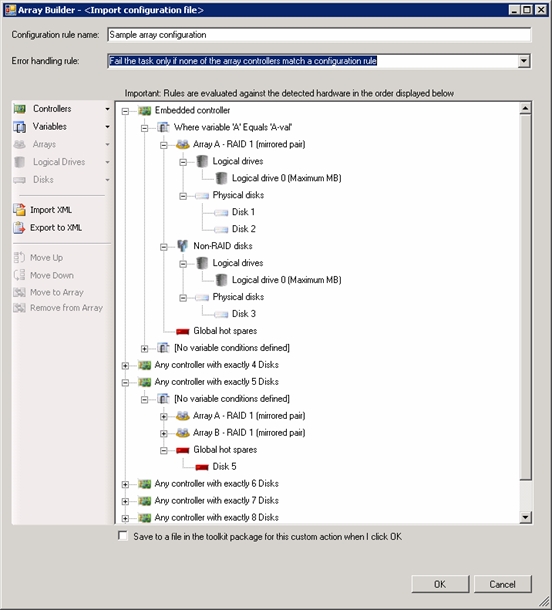Array Builder is a tool that defines rules for configuring array controllers in target servers based on several variable factors. By taking a rules-based approach, you can define standard array configurations for your company and configure your servers according to these standards, without having to know the exact physical configuration of the array controller and disks before you start your deployment.
How the Array Builder works
When you run the task sequence on a target server, the array configuration utility detects the existing controllers in the system as well as the disks attached to each controller. The custom action then tries to match the physical configurations it detected to the logical configurations you defined in the configuration rules.

You can define rules to match configurations based on the detected slot number of the controller or the embedded controller, if any, how many disks are attached to the controller, or you can apply a blanket configuration to any controller that is found. You can also apply configuration rules based on task sequence variables detected on the system. You can define different configurations to servers even if the detected hardware is identical.
Using Array Builder, you can define arrays / disk sets with all available RAID settings, logical drives / virtual disks of varying sizes or use all available space, and assign hot spares to individual arrays or assign global hot spares to the controller.
Error handling rule
There are times when you want to apply a very specific set of configuration rules to target servers and to fail when any one of the rules does not match a controller in the system. At other times you might want to apply a large blanket set of rules to all servers and fail only when no rule matches a controller. The Array Builder error handling rule setting controls that action.
- Fail the task if any controller does not match a configuration rule – will report a failure on the task if any of the detected controllers are not able to be configured by a rule.
- Fail the task only if the first controller does not match a configuration rule – will report a failure if the first controller detected (usually the embedded controller) cannot be configured by a rule.
- Fail the task only if none of the array controllers match a configuration rule – reports a failure only if all of the controllers in the system fail to match a rule, leaving none configured.